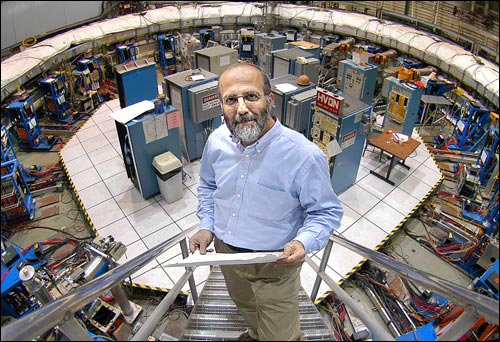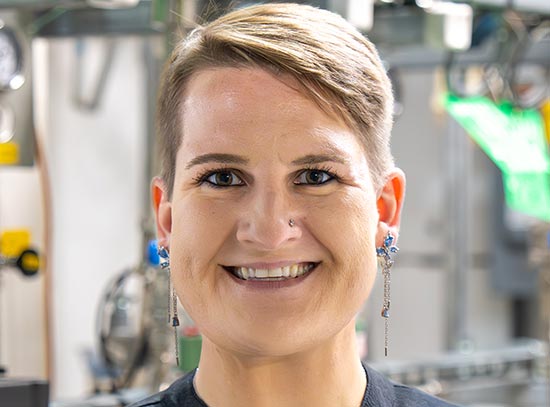Brookhaven Lab's Yannis Semertzidis Named American Physical Society Fellow
January 5, 2006
UPTON, NY - Yannis Semertzidis, a physicist at the U.S. Department of Energy's Brookhaven National Laboratory, has been elected a Fellow of the American Physical Society (APS), a professional organization with about 43,000 members. The APS Fellowship program recognizes members who have made significant contributions in the field of physics. Each year, no more than one-half of one percent of the current membership of the society are recognized by their peers for election to the status of Fellow. Semertzidis is among 202 new Fellows elected in 2005.
 enlarge
enlarge
Yannis Semertzidis inside the muon storage ring used in the g-2 experiment (click image to download hi-res version).
Semertzidis's citation reads: "For leadership in the development of electrostatic quadrupoles and transient magnetic field measurements and for analysis of the muon g-2 experiment."
In the muon g-2 experiment, an international team of physicists used a superconducting magnet that is the world's largest in diameter and an intense beam of protons from Brookhaven's Alternating Gradient Synchrotron to refine one of high-energy physics' most precise measurements: how the spin motion of subatomic particles called muons is affected as they move through a magnetic field. In 2004, the muon g-2 team announced that the measurements disagreed with theory as described in the Standard Model of particle physics, suggesting that exciting new physics discoveries may be on the horizon. More experiments will be needed to verify the discrepancy. (For more information, see this page.)
An extremely uniform magnetic field was needed for the best chance of the most precise measurement in the muon g-2 experiment. As electrostatic quadrupole team leader during the construction of the experiment, Semertzidis, with his team, introduced a new design for the quadrupoles - a series of electrical charge configurations - that eliminated charge buildup, which could, if left unchecked, create background magnetic fields. Thus, they made the experiment more reliable. In addition, they used the charge that was left in the field to measure the electric field strength inside the quadrupoles, an important measurement for experimental accuracy.
Further, the new quadrupole design eliminated the need for a very high vacuum, which would be expensive and difficult to maintain, thereby making the experiment more economical and flexible. Semertzidis and his team also minimized the creation of transient magnetic fields in the experiment's sophisticated injection system - another factor that could affect experimental accuracy - and they designed an innovative laser system to measure the remaining transient magnetic fields.
In addition, Semertzidis helped to improve the accuracy of the experiment by eliminating significant background interference caused by the high rate of experimental data, and he invented a new method of detecting background interference of unknown origin that might distort experimental accuracy.
A native of Greece, Semertzidis earned a B.S. in physics from Aristotle University of Thessaloniki, Greece, in 1984. He went on to earn an M.S. and Ph.D. in physics from the University of Rochester, in 1987 and 1989, respectively. Semertzidis was a research associate at the University of Rochester before joining Brookhaven Lab as an assistant physicist in 1992. He was also a Fellow at CERN, the European Organization for Nuclear Research in Switzerland, from 1993 to 1995. In 2003, Semertzidis received the Brookhaven Science and Engineering Award.
Semertzidis is the initiator and co-spokesperson of a proposal to build a magnetic storage ring at Brookhaven for an experiment that might elucidate a question that has puzzled scientists for decades: the reason why there appeared to be more matter than anti-matter in the universe immediately after the Big Bang. The experiment would search for the electric dipole moment - a technical measurement involving electric charges - of a subatomic particle, called a deuteron, using a small accelerator. If the experiment is successfully implemented, it also will help physicists explore models of physics beyond the Standard Model.
2006-10404 | INT/EXT | Newsroom









